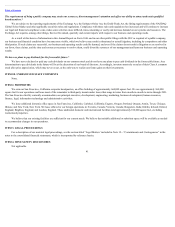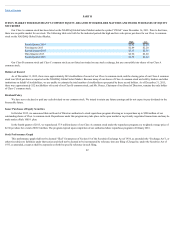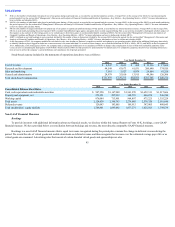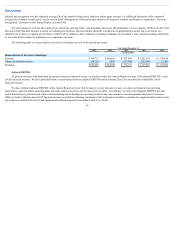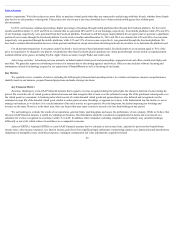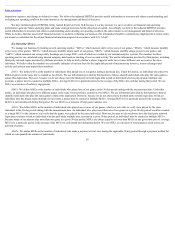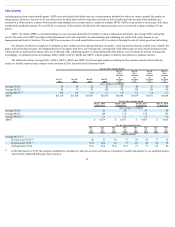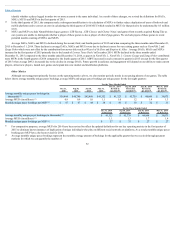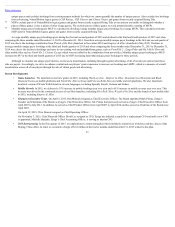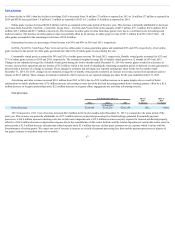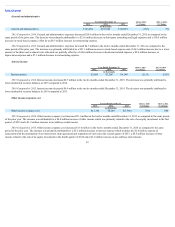Zynga 2015 Annual Report Download - page 53
Download and view the complete annual report
Please find page 53 of the 2015 Zynga annual report below. You can navigate through the pages in the report by either clicking on the pages listed below, or by using the keyword search tool below to find specific information within the annual report.
Table of Contents
transaction expenses, and change in deferred revenue. We believe that adjusted EBITDA provides useful information to investors and others in understanding and
evaluating our operating results in the same manner as our management and board of directors.
We have included adjusted EBITDA in this Annual Report on Form 10-K because it is a key measure we use to evaluate our financial and operating
performance, generate future operating plans and make strategic decisions for the allocation of capital. Accordingly, we believe that adjusted EBITDA provides
useful information to investors and others in understanding and evaluating our operating results in the same manner as our management and board of directors.
While we believe that this non-GAAP financial measure is useful in evaluating our business, this information should be considered as supplemental in nature and is
not meant as a substitute for the related financial information prepared in accordance with U.S. GAAP.
KeyOperatingMetrics
We manage our business by tracking several operating metrics: “DAUs,” which measure daily active users of our games, “MAUs,” which measure monthly
active users of our games, “MUUs,” which measure monthly unique users of our games, “MUPs,” which measure monthly unique payers in our games, and
“ABPU,” which measures our average daily bookings per average DAU, each of which is recorded by our internal analytics systems. The numbers for these
operating metrics are calculated using internal company data based on tracking of user account activity. We use the information provided by third parties, including
third party network logins provided by platform providers, to help us track whether a player logged in under two or more different user accounts is the same
individual. We believe that the numbers are reasonable estimates of our user base for the applicable period of measurement; however, factors relating to user
activity and systems may impact these numbers.
DAUs . We define DAUs as the number of individuals who played one of our games during a particular day. Under this metric, an individual who plays two
different games on the same day is counted as two DAUs. We use information provided by third parties to help us identify individuals who play the same game to
reduce this duplication. However, because we do not always have the third party network login data to link an individual who has played under multiple user
accounts, a player may be counted as multiple DAUs. Average DAUs for a particular period is the average of the DAUs for each day during that period. We use
DAUs as a measure of audience engagement.
MAUs. We define MAUs as the number of individuals who played one of our games in the 30-day period ending with the measurement date. Under this
metric, an individual who plays two different games in the same 30-day period is counted as two MAUs. We use information provided by third parties to help us
identify individuals who play the same game to reduce this duplication. However, because we do not always have the third party network login data to link an
individual who has played under multiple user accounts, a player may be counted as multiple MAUs. Average MAUs for a particular period is the average of the
MAUs at each month-end during that period. We use MAUs as a measure of total game audience size.
MUUs. We define MUUs as the number of individuals who played one or more of our games, which we were able to verify were played by the same
individual in the 30-day period ending with the measurement date. An individual who plays more than one of our games in a given 30-day period would be counted
as a single MUU to the extent we can verify that the games were played by the same individual. However, because we do not always have the third party network
login data necessary to link an individual who has paid under multiple user accounts in a given 30-day period, an individual may be counted as multiple MUUs.
Because many of our players play more than one game in a given 30-day period, MUUs are always equal to or lower than MAUs in any given time period. Average
MUUs for a particular period is the average of the MUUs at each month end during that period. We use MUUs as a measure of total audience reach across our
network of games.
MUPs . We define MUPs as the number of individuals who made a payment at least once during the applicable 30-day period through a payment method for
which we can quantify the number of individuals,
50



